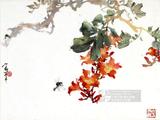名畫薈萃 冊 宋梁楷山陰書箑圖
推薦分享
資源連結
連結到原始資料 (您即將開啟新視窗離開本站)後設資料
- 資料識別:
- 故畫001238N000000002
- 資料類型:
- 類型:繪畫
- 型式:靜態圖像
- 著作者:
- 梁楷
- 主題與關鍵字:
- 聖賢 百姓 文房用具 扇 楊柳
- 出版者:
- 數位化執行單位:國立故宮博物院
- 格式:
- 本幅 31.3x58.9公分、全幅 47x81.3公分
- 關聯:
- 石渠寶笈初編(重華宮),下冊,頁735-736&*故宮書畫錄(卷六),第四冊,頁199-200&*故宮書畫圖錄,第二十九冊,頁214-219&*梁楷,山東東平人。他是南宋寧宗嘉泰年間(一二○一—一二○四)的畫院待詔,最擅長畫人物,因為筆墨疏放、形象簡潔,而被形容為「減筆」。 本幅描繪老婦人手拿紙扇,正在向書聖王羲之(三二一—三七九年)乞求題字,身後還有一名侍從,捧著硯台侍候。畫中每個人物均表情生動,衣紋線條瀟灑流暢,雖然不見得是梁楷親筆所作,卻能充分掌握住寫意人物的簡率趣味。&*Liang K'ai served as a Painter-in-Attendance in the Chia-t’ai era (1201-1204) at the court of Emperor Ning-tsung. Liang K'ai specialized in figure painting. Due to his reduction of the brushwork for a spirited effect, his style has been described as “abbreviated brushwork”. The subject of this work is an anecdote about China's Sage Calligrapher Wang Hsi-chih (321-379). He is shown helping an old lady sell her fan by inscribing it with his famous calligraphy. Behind is an attendant holding an inkstone. The expressions of the figures are lively and the drapery is done with fluid brushwork. Although not necessarily a work by Liang K'ai, the artist here was still able to capture the essence of the abbreviated “sketching ideas” style of brushwork.&*Liang K'ai, a native of Tung-p'ing, Shantung, was a Southern Sung Painter-in-Attendance in the Painting Academy in the Chia-t'ai era (1201-1204) of Emperor Ning-tsung. He did figures in brushwork that was reduced but still transmitted the spirit, in painting history being praised as “abbreviated brushwork”. This work has a signature of Liang K'ai, the features of which are similar to those of other surviving Liang K'ai works, but it is still uncertain whether it was added by a later hand or not. As a work is passed down through the years, it often undergoes many transformations. A signature may be removed or the signature of a famous artist added to an unsigned work, thereby removing evidence of or obscuring the original artist.
- 管理權:
- 國立故宮博物院
授權聯絡窗口
- 國立故宮博物院圖像授權、出版授權、影音資料授權-申請流程說明
http://www.npm.gov.tw/zh-TW/Article.aspx?sNo=03003061






